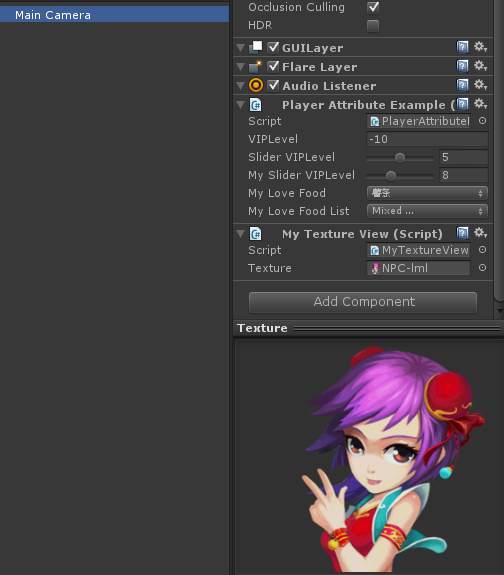
using UnityEngine; using System.Collections; public class MyTextureView : MonoBehaviour { public Texture texture; }
using UnityEngine; using System.Collections; using UnityEditor; //CustomEditor 自定义编辑器 //描述了用于编辑器实时运行类型的一个编辑器类。 //注意:这是一个编辑器类,如果想使用它你需要把它放到工程目录下的Assets/Editor文件夹下。 //编辑器类在UnityEditor命名空间下。所以当使用C#脚本时,你需要在脚本前面加上 "using UnityEditor"引用。 [CustomEditor(typeof(MyTextureView))] public class MyTextureViewEditor : Editor { MyTextureView myView; void OnEnable() { myView = target as MyTextureView; } //重载是否有预览窗口 public override bool HasPreviewGUI() { return true; } //自定义预览窗 public override void OnPreviewGUI(Rect r, GUIStyle background) { if (myView.texture != null) { GUI.Box(r, myView.texture); } } //重写预览窗标题 public override GUIContent GetPreviewTitle() { return new GUIContent("Texture"); } }
编辑MyTextureView 继承至ScriptableObject
using UnityEngine; using System.Collections; public class MyTextureView : ScriptableObject { public Texture texture; }
在MyTextureViewEditor中添加以下代码,可在Project中创建资源
[MenuItem("Tools/CreateMyViewObj %2")] static void CreateMyViewObj() { Debug.Log("CreateMyViewObj"); var sc = ScriptableObject.CreateInstance<MyTextureView>(); //CreateAsset 在指定的路径新建资源。 //你必须保证使用的路径是一个被支持的扩展 //('.mat' 代表 materials, '.cubemap' 代表 cubemaps, '.GUISkin' 代表 skins, '.anim' 代表 animations and '.asset' 代表任意其他的资源文件。) AssetDatabase.CreateAsset(sc, "Assets/Default.asset"); //将所有未保存的资源更改写入磁盘。 AssetDatabase.SaveAssets(); }
